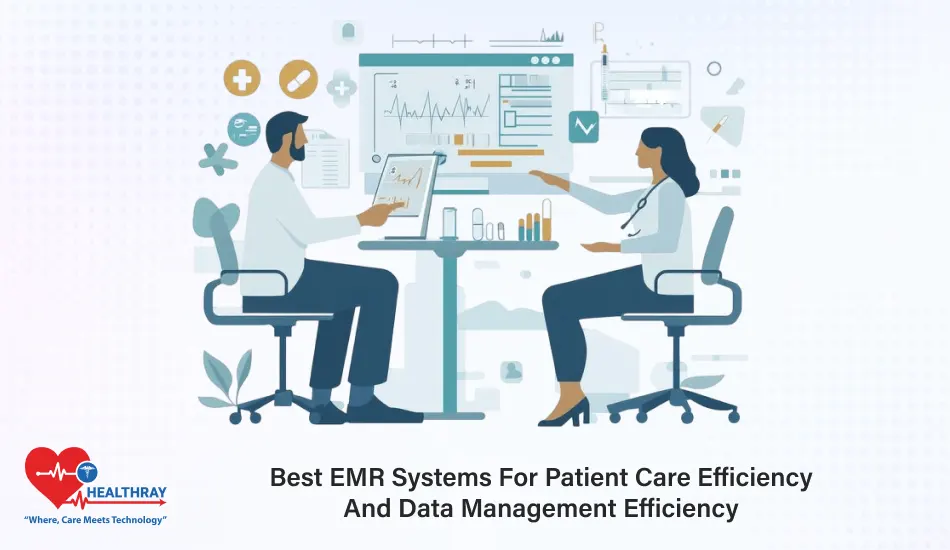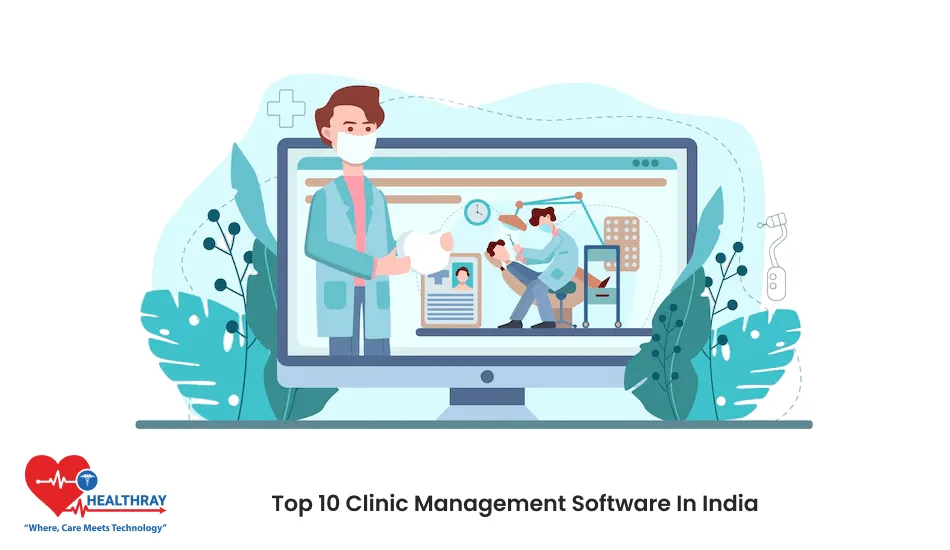Introduction
Choosing the best EMR is more important than any other aspect of technology. The best EMRs will actually change the world for healthcare professionals, doctors, and technology leaders in terms of how they provide patient care and run their operations. They are the backbone of daily practice-they give access to data, while also ensuring that data is secure and efficient to manage. The kind of improvements in patient records through complex workflows, though small, add up to vast improvements for patients and providers alike.
This guide breaks down all of the top EMR systems on the current market, Healthray included, and tells about their strengths and differences. You will know by the end of this article-well, you are going to have a really good grasp of which system may work best for your practice, what to expect in terms of ease of use, and how each solution will enhance the experience of patients. Whether you’re looking for user-friendly interfaces, rock-solid data security, or seamless interoperability with existing systems, we have them all covered.
Criteria to Evaluate EMR System Criteria to Evaluate EMR System: Healthray
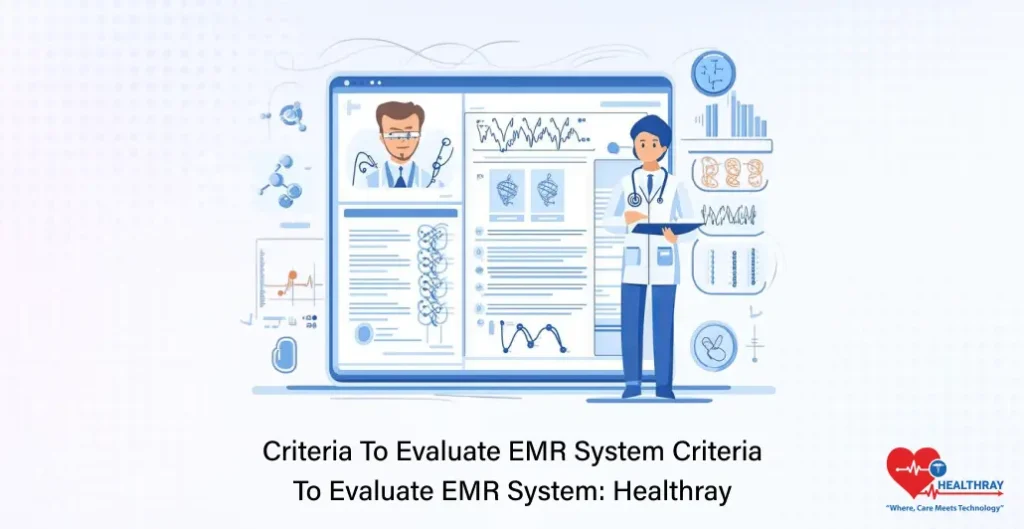
An EMR system must be well evaluated before selection since it conforms to the needs of that particular healthcare practice. The fact of the matter is, not all systems are built the same, and knowing what to prioritize can save time down the road and money too. These are the essential criteria that must be considered when evaluating EMR systems:
User-Friendly Interface
A system that is intuitive and user-friendly is what healthcare professionals require. When an EMR is straightforward, it better enables providers to spend precious time with their patients, not wrestling with complexities within software. Healthray and systems outlined in this guide are designed around simplicity so that minimal training is required, and enable a greater reduction of error during use.
Interoperability
An important aspect of an EMR system is interoperability-meaning that it must be able to share medical data easily with other health platforms. It permits seamless data exchange collections tied into different departments and practices generally as they’re built in multiple hospitals. Particularly, having a complete, unified view of the patient’s medical history for better decisions in continuity of care.
Customization and Scalability
Nothing could be more pertinent to any hospital’s scenario than the need for flexibility because every feature about the healthcare setting is changing. The best EMR platforms offer scalable solutions that grow with practice. Customizing the workflows, the templates, the ways interactions with the patient work, and then making the software feel virtually as if or as close to a custom fit as possible for that practice, are the choices providers basically have for customizing their EMR solution.
Compliance with Healthcare Regulations
There cannot be an “adherence or a failing” to healthcare regulations such as HIPAA in the United States. The priority of a system would be geared towards security, requiring strong access controls, encryption, and routine compliance updates. Systems with built-in regulatory support give peace of mind to providers that legal requirements are satisfied and patient information is secured.
Cost and Implementation Assistance
Although it is costly, investing in EMR systems can become slightly burdensome for smaller practices. Differences in the prices of systems also vary. Pay per user is one of them, while some would go subscription-based. Aside from the price, the vendor’s support during and after implementation should also be assessed. A thorough onboarding process, training, and back-up support would ease transition and ultimately establish satisfaction.
These points make it easy to evaluate an appropriate EMR and choose the right one for every setting in healthcare. Efficient and effective systems will transform the efficiency and the care of patients while adding lasting value for years to come.
Top EMR Systems Overview
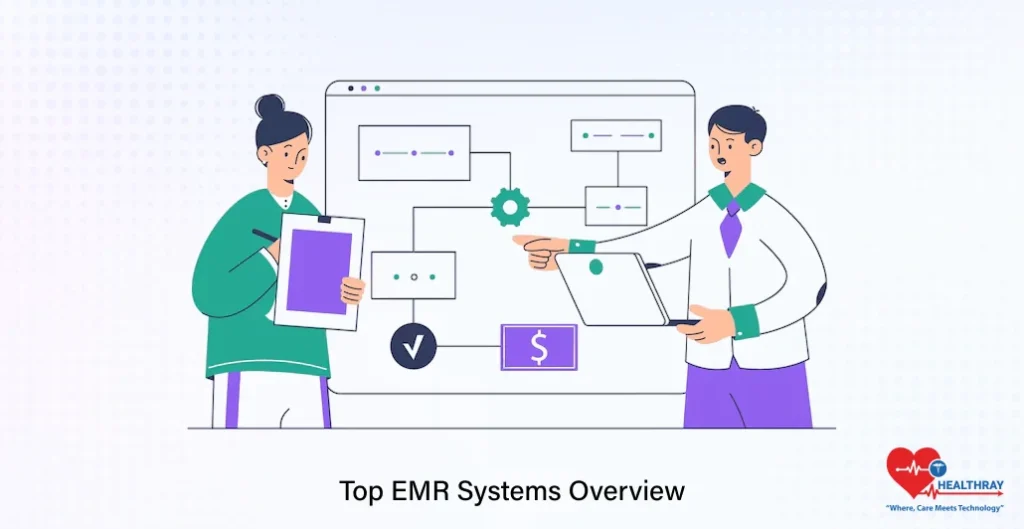
The EMR market is diverse, with systems tailored to various types of healthcare facilities. Below, we’ve compiled a list of top Electronic Medical Record systems, including Healthray, highlighting their standout features and how they support both patient care and data management. This comparison aims to help healthcare professionals, technology leaders, and doctors choose the system that best fits their needs.
Healthray
Healthray is designed to be the most user-friendly and accessible to ease the burden of hard-working practicing healthcare providers. Data handling must be quick and simple with the clear interfaces that it provides, allowing health professionals and medical staff to access patient data instantaneously without the extra baggage of cumbersome systems. The other big emphasis of Healthray is integration with other tools and platforms within a healthcare setting, making it even more customizable for different practices.
Bigscal
With many features and capabilities, Bigscal holds its reputation as a widely accepted platform among large hospitals and complex healthcare organizations. It proposes an end-to-end suite from scheduling to billing of patients with some advanced analytics on healthcare data insights. One more factor that adds to Epic’s goodwill is its interoperability since it aids in communication among various health systems thus making life easier for larger practices with different needs.
Case Studies and User Experience
Healthray has proven useful in diverse healthcare environments, enhancing patient care, workflow, and data management. Below are some emr systems examples and comments by users from different scenarios demonstrating how Healthray empowers healthcare providers in day-to-day activities.
Improving Small Practice Workflow
A very small family medicine practice implemented Healthray to bring some structure to their operations. Ease of use and excellent data management were truly helpful. Staff could look up patient information very quickly, which cut down on administrative hours and increased time for the actual practice of patient care. The customization of Healthray allowed the practice to customize workflows to their own specifications, thereby minimizing errors and improving coordination among team members.
Enhanced Data Access for Large Clinics
As a great clinic meritocracy, the network implemented Healthray to promote data access across various locations. The system took it upon its sacred shoulders to facilitate the secure transfer of patient records amid various branches, for the very sake of continuity in care. With integrated data-sharing capabilities in Healthray, providers would be reliably sure to know the in-and-out of a patient’s complete medical history, therefore engaging knowledgeably in decision-making and coherence of treatment plans. To sweeten the deal, it also presented a user-interface experience that forms an easy avenue for every staff that is new in the business in terms of training.
Supporting Telehealth in Outpatient Settings
An outpatient clinic for remote consultations found Healthray cloud structure ideal for web support of telehealth services. Easy online access by patients to their records increased the level of engagement and helped them stay informed about their care. The clinic staff liked that telemedicine appointments were simply integrated into the Healthray system for a seamless experience for both provider and patient. Healthray’s communication tools helped strengthen connections between providers and patients, which is especially important in virtual care settings.
Reporting Done for Medical Groups-Past and Future
A medical group whose leadership assignments encompass reporting and performance tracking plus patient record tasks adopted Healthray for these objectives. Reports generated by Healthray enabled the administration to monitor real-time engagement through metrics such as patient outcomes and clinic efficiency. The conveyed insights helped the medical group put their finger on key areas for improvement for enhanced patient experience and administrative efficiency. Healthray’s easy adaptability further allowed the medical group to customize it according to their specific needs.
Mobile Access for General Practitioners
In need of a system matching their physicians’ mobile needs, a busy general practice finds Healthray perfect. Compatible with both tablets and smartphones enabled doctors to access and update patient records during their visits. These settings improved the accuracy of patient records, allowing doctors to provide instant updates and thus improving patient care. With Healthray, mobile capabilities also enabled the providers to remain connected to their workflow outside the computer, thus, a reliable resource for the on-the-road healthcare professional.
Comparative Study of Key Features across EMR Systems
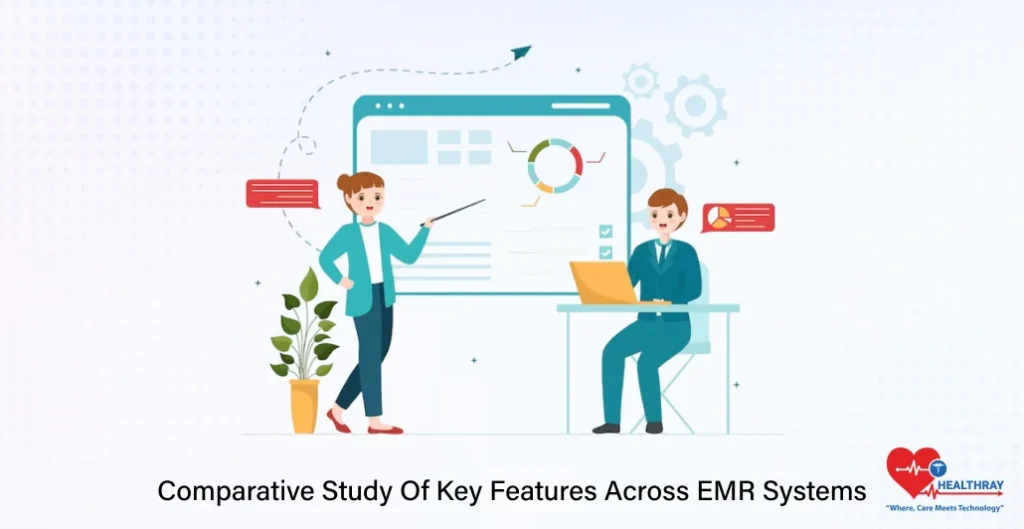
Finding the right electronic medical record (EMR) system can be quite difficult, with too many similar options boasting similar functionalities. This is where a feature-to-feature comparison will offer more intelligent insights into the most important aspects, like functionality, price, usability, and support with a magnifying glass look into the impressive abilities that Healthray has in all these aspects.
User Interface and Usability
It is straight in the Healthray design for ease access to patient information, making it ideal from the perspective of providers going for efficiency in their practice. Other systems have everything between those too flexible designs to nasty rigid ones, depending on whether they target different practices. Usability is important because a better-designed system means diminished time in training and errors.
Interoperability
Healthray readily integrates with other platforms throughout the healthcare field while also allowing smooth patient data flows throughout the different tools in a practice. Interoperability constitutes a large part of almost every one of the best programs that enables functionalities such as easier communications across departments and external partners. Those systems emphasizing data sharing capabilities usually yield more effective continuity of care since all medical facilitators involved access updated patient records.
Customization Versatile and Scalable
Healthray is flexible enough to provide scalable solutions that grow along with the practice. Customize templates, workflows, and patient interactions according to own specific needs. Customization options allow for some adaptation to the particular culture of a health institution. Other EMR systems also possess some level of scalability; however, some factors are tailored better toward either smaller practices or larger institutions due to the granularity offered in customization.
Data Security and Compliance
Healthray incorporates mechanisms within the framework of patient-data security (for example, encryption and access control) to meet compliance requirements specified in healthcare legislation, such as HIPAA. Compliance and data security are core elements of the EMR systems, though comparatively different in how they undertake the protection of patient data. Providers are more confident in ever having their patient data managed with immense privacy and protection through systems that possess robust security protocol.
Cost and Support Services
Healthray’s pricing is very flexible and suitable for practices of all sizes and budgets. Apart from offering very competitive prices, Healthray also provides the best support throughout the process of implementation and day-to-day use. This means a smooth transition for new clients. Other systems vary considerably regarding their pricing models. While some offer subscriptions or pay-per-user pricing, support levels differ and should be part of your considerations when choosing the systems that offer easy onboarding and training.
This comparative study places Healthray amidst other electronic medical record offerings and helps healthcare institutions zero in on the features that matter mostly to their specific settings. Thoughtful consideration of these features can simplify and enlighten the choice of EMR: one ultimately supporting the practice bowl goals in patient care and data management.
Case Studies and User Experiences
Choosing the right EMR system will heavily influence patient care and workflow; real-world examples prove how capable these systems can be. Herein, we will examine how Healthray and other leading EMR systems have benefited various healthcare practices.
Healthray for Improving Patient Care Coordination
Healthray was implemented by one mid-sized private practice to improve patient care coordination. With the introduction of the Healthray, the clinic was able to reduce manual data entry time and allow for better patient records access. Quick access to updated patient information allowed health providers to make well-informed decisions faster, enhancing overall patient care. Consequently, integration of Healthray with other tools within the clinic fostered improved inter-clinic communication, leading to better handoffs and fewer gaps in patient care.
Improved Workflow for Busy Practices
Most healthcare facilities have also reported considerable improvement in the workflow after the adoption of efficient EMR systems. A flexible EMR solution considerably cut waiting time and reduced administrative errors in another case of a fast-moving practice. With automated scheduling and updating patients in real time, the staff were able to respond better to appointments and follow-ups, greatly enhancing patient satisfaction and optimization of day-to-day operations.
Secure Data and Compliance
For practices with data in their hearts, compliance-oriented EMR systems have become paramount. In one case, a healthcare service provider had the solution with maximum security features in place to protect its very sensitive data. This practice really upgraded its data security by encryption protocols and user-access controls that lessened the dread of data breaches. Likewise, Healthray emphasizes data protection by offering such features that help practices comply with health regulations and secure patient data.
Great Feedback from Providers and Staff
Feedback from healthcare users shows that EMR systems like Healthray positively impact both providers and administrative staff. One healthcare clinic noted that the intuitive nature of Healthray shortened onboarding time, enabling staff to transition smoothly onto the system in a timely manner. Not only did this ease of use lead to an increase in productivity, but it also reduced the number of errors as staff were able to more reliably enter and retrieve patient data. Practices that emphasize choice of user-friendly EMRs often record similar expériences: smoother workflows and more satisfied staff.
Real-time instances such as these tell about how with choosing the right EMR system such as Healthray; smooth running of operations, better outcomes for the patients, and high satisfaction among healthcare professionals and staff could be realized. Evaluating case studies and user experiences is helpful for any practice in the business of considering EMR alternatives, as it sheds light on benefits, potential, and ramifications offered by each EMR option.
Implementation Factors
Setting up any new EMR system means painstaking preparation and planning to accomplish necessary and smooth rollouts with the least disruption in the daily routine. Some key considerations for a successful implementation are given, with particular regard to improving Healthray’s support to healthcare practices in this endeavor.
Assessing Practice Needs and Setting Goals
The health professional world, before selecting any EMR system, has to assess its needs and set goals. Are they trying to single-handedly improve patient care coordination, or reduce administrative tasks, or enhance data security? Clearly defining goals sets the basis for selecting an EMR system that would have fit the practice’s unique requirements very well. Healthray, for example, has variable features making it viable for practices of all sizes and specializations.
Preparing for Workplace Data Migration
Data migration sometimes proves to be an arduous step in the EMR transition process, especially while migrating all the data from a legacy system. The transfer of patient records, billing details, and such critical information needs to be planned thoroughly so that loss of information or inaccuracies do not occur. Since Healthray and other solid EMR providers usually offer migration assistance, they always facilitate a practice’s transfer of its data smoothly while guaranteeing safe transport of vital information.
Staff Training and Onboarding
A new EMR system means that changes in workflows must be made, and training remains an important part of this process. A great resource such as Healthray reduces the learning curve, but some dedicated time for all users to be trained properly will help everyone feel comfortable with the new system. Practices will need to allow for deliberation on how to best frame this process, ensuring ample time for onboarding to promote staff familiarization with new features and workflows. Many EMR vendors, including Healthray, provide onboarding support and training resources to facilitate the process.
Testing and Gradual Rollout
It is seldom a case of “just switch it on and go” for a new EMR system. Many practices prefer, instead, to test the system in a limited capacity before full-scale rollout. This provides a phase in which any problematic areas may be identified to be tweaked toward a smoother operation. And being flexible and scalable, the design of Healthray allows practices to customize the implementation to suit their immediate and future needs, thus making it easier to test and gradually adjust the settings.
Support and Maintenance
EMRs need to be upgraded regularly to remain consistent with compliance standards, cybersecurity protocols, and technical advancements. Choosing a product provider like Healthray that shall provide ongoing support ensures the EMR of a practice is always updated and functional. Support services offered even after implementations are essential to quick resolution of any arising issues to avoid downtimes in patient care.
Monitoring and Evaluation of System Performance
After the EMR system is set up, practices need to monitor its performance and evaluate its impact on their day-to-day activities and patient care. Regular check-ins will help assess areas of improvement and ensure the system is in line with the practice’s goals. Healthray offers analytical tools that empower practices to monitor usage patterns in order to identify aspects of workflow that can still be further optimized.
Implementation, therefore, involves some important steps in an EMR system, but with the right approach, smooth transition for healthcare practice is ensured. Providers like Healthray seek to streamline this process by being an ally all the way from data migration to maintenance support, allowing healthcare professionals to concentrate on what matter most quality patient care delivery.
Conclusion
Choosing the right EMR system will enhance patient care and streamline healthcare operations. Every system has its distinctive strengths, from easy use to great data security and full-on integration with other healthcare tools. Healthray lies head and bay far above others because of its commendable features and support, hence the best choice when reliability and adaptability are seeking avenues for healthcare providers.
The best Hospital Management System, in the end, is one on which a practice’s specific needs and goals stand, supporting both patient care as well as adequate data management. Keeping in mind the usability, interoperability, scalability, and security of data will enable professional healthcare workers to make a decision that is in the best interest of their practice for the years to come. Creating the right EMR will allow for enhanced patient experience and for the practice to streamline workflow and deliver quality care.
